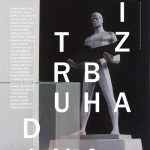GROUP EXHIBITION “Iz trbuha diva”/”From Within the Giant’s Belly”
August 12th – September 7th, 2015
Museum of Modern and Contemporary Art (MSU)
Dolac 1/II, Rijeka, Croatia
Opening night: Wednesday, August 12 at 8 pm, MMSU
Performance by Siniša Labrović: Leisure (Communist Manifesto), Saturday, September 5, 20:00
Working hours: Tuesday – Friday: 5 – 9 pm, Saturday and Sunday: 11 am – 2 pm i 6 – 9 pm
Guided tours and evening cinema: Thursday, 20/8 and 3/9 at 8 pm.
Film screenings:
Nadija Mustapić & Marin Lukanović: Rikard Benčić, for example and Jenny Perlin: Perseverance & How to Develop It, 20/8 at 9 pm; Marijan Crtalić: Industrial Paradise and Harun Farocki: Workers leaving the factory, 3/9 at 9 pm on the terrace of the Museum.
Artists featured in the MMSU collections: Darko Bavoljak, Dušan Džamonja, Sergije Glumac, Edo Kovačević, Pawel Kowzan, Mila Kumbatović, Zlatko Kutnjak, Gabriele Mucchi, Nadija Mustapić & Marin Lukanović, Rene Rusjan, Vjekoslav Parać, Sava Šumanović, Romolo Venucci
Invited artists: Marijan Crtalić, Boris Cvjetanović, Matija Debeljuh, Harun Farocki, Alen Floričić, Josip Pino Ivančić, Mikhail Karikis & Uriel Orlow, Zlatko Kopljar, Siniša Labrović, Kristina Leko, Luiza Margan, Marko Marković, Jenny Perlin, Goran Škofić
Continuing from The Industrial Landscape hosted by the Museum in 2005, this exhibition gathers works from the MMSU collection and works of invited artists. In the sketchy format the show attempts to capture the relationships between art and industry throughout the 20th century. It speaks about faith and distrust in factories, especially in the context of their massive shutdown at the height of post-transition. Finally, it follows the artists’ reactions to industrial and post-industrial environment, which is implied in the title Within the Giant’s Belly that comes from Luiza Margan’s project about the inert status of Rijeka’s former shipbuilding giant “3. maj”.
Providing locally specific examples, some of the works associate the processes of deindustrialization with the widespread flexibilization of labor conditions and the expansion of global economy. In addition, the works from the Museum’s collection deal with different projections of labor, exploring the changes of the industrial landscapes before and after of the 1990s. The distinctions between the useful and the useless, the mechanized and the deviant, progress and deterioration, are described as contentious. This is connected with the dubious alliance between labor crisis and degradation of urbanity, where public and social, and even imaginary, spaces stumble against the logic of the global free market and expendability.
If movement and speed, as the byproducts of industry and machines, are the characteristic of the 20th century, when this type of art was born, we may ask ourselves, what is the image of labor in contemporary art? In what way do works of art depict the sideways of progress and how do they resist the practice of reducing labor to the cold quantitative? In the atmosphere of ruined factories, unemployment surge and life on credit, questions emerge as to the culture of labor, taken out from the context of work necessity and imperatives of efficiency. There is a rumble and growl coming from within the giant’s belly. A different light is shed on the postponed segments of reality, on the hidden or neglected details of work panoramas. These details point to inconsistencies in today’s labor system and call for estrangement from the everydayness and normalness, encouraging us to take a luddite defense against utter exhaustion caused by work, or by job hunt, inspiring us to take a stand. To practice our imagination. To practice defiance.
Curator: Ksenija Orelj
Assistant at the exhibition: Neva Lukić
Pipelines? I thought I saw them encompassing the entire globe, and through them flows water, oil, blood.
(Mila Kumbatović)













